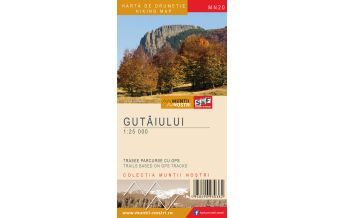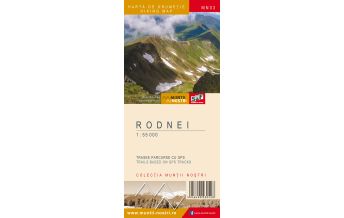Wanderkarte MN-21, Harghitei 1:80.000
Ostkarpaten

Tags
The Harghita Mountains are a mountain group in the Eastern Carpathians, bordered to the north by the Gurghiu Mountains via Sicasau Valley and Sicas Pass (Liban), by Giurgeu Depression and Giurgeu Mountains via Gretes Pass; to the east by Ciuc Depression; to the south by Bixad Depression and Baraolt Mountains via Hatod Pass, by the small depressions of Batani, Baraolt, Varghis, and then by Persani Mountains via Varghis Valley; to the west by Homorodul Mic Valley and the small depressions of Vlahita, Capalnita, Zetea and Tarnava Mare Valley.
The geology of the Harghita Mountains consists of volcanic agglomerates alternating with thin layers of sedimentary rocks (which are more common in the craters of the massif and Luci Cauldron), and the main ridge is made up of a huge mass of andesite rocks with pyroxenes and amphiboles, pyroclastites and basaltic andesite rocks. The highest peaks are Harghita Madaras Peak 1,800 m, Harghita Ciceu Peak 1,764 m, Fertau Peak 1,589 m, and Mount Cucu Peak 1,557 m.
The most important tourist attractions are the marsh-type nature reserves and peat bogs with flora and fauna typical of oligotrophic marshes: Mohos (the most extensive surface area), Dracului Lake, Dumbrava Harghitei, Luci, Budos, and Mina Brook. Sfanta Ana Lake, the only lake in a volcanic crater in the country, should also be mentioned. And last but not least, the abundance and diversity of mineral springs and spa resorts (mineral water pools).
The map of Harghitei Mountains (MN21) is the 21st map of the new Muntii Nostri collection.
The map was edited using the latest mapping techniques and it was printed on moisture resistant paper. It is easy to read and simple to use due to the mapping styles, specific to Schubert & Franzke company, and as a result of practical information structuring. It is handy and everything is exactly where it should be. The map is useful for both hiking enthusiasts and professionals.
The Harghita Madaras, Hargita-Bai, Mount Ciomatu areas was digitized at a more detailed scale: 1 : 25 000 and the Varghisului Gorge area was digitized at a more detailed scale: 1 : 10 000.
All the trails have been recorded in the field using a GPS. They are described in detail in both Romanian and English, some trails having representative images attached to them. Each trail has a technical box containing: trail marking checked in the field, trail route, profile with major landmarks, data on difficulty, length, total ascent, total descent, round-trip time, practicability depending on the season and so on. The map also contains the UTM grid, a projected coordinate metric system useful in the quick measurement of distances on the map. Shading and contour lines highlight the landscape and facilitate orientation.
Publisher:
Series:
Scale:
1:65.000
Product Type:
Maps
Language:
English, Romanian
EAN:
5948490930412
Year of publication:
2019
Continent: Europe
Country: Romania
Places / Mountains / Lakes: Szentegyháza, Csíkszereda, Csíkszentdomokos, Csíkmadaras, Zetelaka, Lövéte, Barót, Tusnádfürdo, Sepsibükszád
Write Your Own Review
No manufacturer information and safety instructions available yet.






